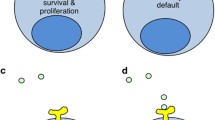Abstract
Developmentally regulated mouse gene Nedd2 encodes a protein similar to the product of the nematode Caenorhabditis elegans cell death gene ced-3 and the mammalian interleukin-1β-converting enzyme. Overexpression of Nedd2 in cultured mammalian cells induces apoptosis that can be blocked by proto-oncogene BCL2. We have isolated cDNA clones for the human homologue of the mouse gene and, by using these as probes, mapped the human NEDD2 gene to 7q34-35 by fluorescence in situ hybridisation. The potential tumour suppressor function of NEDD2 is discussed.
Similar content being viewed by others
References
Heim S (1992) Cytogenetic findings in primary and secondary MDS. Leuk Res 16:43–46
Isobe M, Erikson J, Emanuel BS, Nowell PC, Croce CM (1985) Location of gene for β subunit of human T-cell receptor at band 7q35, a region prone to rearrangements in T cells. Science 228:580–582
Johansson B, Mertens F, Mitelman F (1993) Cytogenetic deletion maps of haematologic neoplasms: circumstantial evidence for tumor suppressor loci. Genes Chromosom Cancer 8:205–218
Kere J, Ruutu T, Davies KE, Roninson IB, Watkins PC, Winqvist R, Chapelle A de la (1989) Chromosome 7 long arm deletions in myeloid disorders: a narrow breakpoint region in 7q22 defined by molecular mapping. Blood 73:230–234
Korsmeyer SJ (1992) Bcl-2 initiates a new category of oncogenes: regulators of cell death. Blood 80:879–886
Kumar S, Kinoshita M, Noda M, Copeland NG, Jenkins NA (1994) Induction of apoptosis by the mouse Nedd2 gene, which encodes a protein similar to the product of the Caenorhabditis elegans cell death gene ced-3 and the mammalian IL-1β-converting enzyme. Genes Dev 8:1613–1626
Kumar S, Tomooka Y, Noda M (1992) Identification of a set of genes with developmentally down-regulated expression in the mouse brain. Biochem Biophys Res Commun 185:1155–1161
Lawrence JB, Villnave CA, Singer RH (1988) Sensitive, high resolution chromatin and chromosome mapping in situ: presence and orientation of two closely integrated copies of EBV in a lymphoma cell line. Cell 52:51–61
Le Beau MM, Diaz MO, Rowley JD, Mak TW (1985) Chromosomal localization of the human T cell receptor β-chain genes. Cell 41:335
Lichter P, Tang CC, Call K, Hermanson G, Evans G, Housman D, Ward DC (1990) High resolution mapping of human chromosome 11 by in situ hybridization with cosmid clones. Science 247:64–69
Mitelman F, Kaneko Y, Trent J (1991) Report of the committee on chromosome changes in neoplasia. Cytogenet Cell Genet 58:1053–1079
Miura M, Zhu H, Rotello R, Hartwieg EA, Yuan J (1993) Induction of apoptosis in fibroblasts by IL-1 β-converting enzyme, a mammalian homolog of the C. elegans cell death gene ced-3. Cell 75:653–660
Morton CC, Duby AD, Eddy RL, Shows TB, Seidman JG (1985) Genes for β chain of T-cell antigen receptor map to region of chromosome rearrangement in T cells. Science 228:582–584
Neuman WL, Rubin CM, Rios RB, Larson RA, Le Beau MM, Rowley JD, Vardiman JW, Schwartz IL, Faber RA (1992) Chromosomal loss and deletion are the most common mechanisms for loss of heterozygosity from chromosomes 5 and 7 in malignant myeloid disorders. Blood 79:1501–1510
Pinkel D, Strauma T, Gray JW (1986) Cytogenetic analysis using quantitative, high sensitivity, fluorescence hybridization. Proc Natl Acad Sci USA 83:2934–2938
Rabbitts TH, Boehm T (1991) Structural and functional chimerism results from chromosomal translocation in lymphoid tumors. Adv Immunol 50:119–146
Sambrook J, Fritsch EF, Maniatis T (1989) Molecular cloning: a laboratory manual, 2nd edn. Cold Spring Harbor Latoratory, Cold Spring Harbor, NY
Shaw P, Bovey R, Tardy S, Sahli R, Sordat B, Costa J (1992) Induction of apoptosis by wild-type p53 in a human colon tumorderived cell line. Proc Natl Acad Sci USA 89:4495–4499
Takahashi E, Hori T, O'Connell P, Leppert M, White R (1990) Rbanding and nonisotopic in situ hybridization: precise localization of the human type II collagen gene (COL2A1). Hum Genet 86:14–16
Takahashi E, Hori T, O'Connell P, Leppert M, White R (1991) Mapping of the MYC gene to band 8q24. 12-q24.13 by R-banding and distal to fra(8)(q24.11), FRA8E, by fluorescence in situ hybridization. Cytogenet Cell Genet 57:109–111
Takai S, Nishino N, Kitayama H, Ikawa Y, Noda M (1993) Mapping of the KREV1 transformation suppressor gene and its pseudogene (KREV1P) to human chromosome 1q13.3 and 14q24. 3, respectively, by fluorescence in situ hybridization. Cytogenet Cell Genet 63:59–61
Takai S, Kasama K, Yamada K, Kai N, Hirayama N, Namiki H, Taniyama T (1994) Human high-affinity FcgRI (CD64) gene mapped to chromosome 1q21.1-q21.3 by fluorescence in situ hybridization. Hum Genet 93:13–15
Takai S, Yoshida Y, Noda M, Yamada K, Kumar S (1995) Assignment of the developmentally regulated gene NEDD1 to human chromosome 12q22 by fluorescence in situ hybridization. Hum Genet 95:96–98
Viegas-Pequignot E, Dutrillaux B (1978) Une methode simple pour obtenir des prophases et des prometaphases. Ann Genet (Paris) 21:122–125
Wang L, Miura M, Bergeron L, Zhu H, Yuan J (1994) Ich-1, an Ice/ced-3-related gene, encodes both positive and negative regulators of programmed cell death. Cell 78:739–750
Webber LM, Garson OM (1983) Fluorodeoxyuridine synchronization of bone marrow cultures. Cancer Genet Cytogenet 8:123–132
Yonish-Rouach E, Resnitzky D, Lotem J, Sachs L, Kimchi A, Oren M (1991) Wild-type p53 induces apoptosis of myeloid leukaemia cells that is inhibited by interleukin-6. Nature 352:345–347
Author information
Authors and Affiliations
Rights and permissions
About this article
Cite this article
Kumar, S., White, D.L., Takai, S. et al. Apoptosis regulatory gene NEDD2 maps to human chromosome segment 7q34–35, a region frequently affected in haematological neoplasms. Hum Genet 95, 641–644 (1995). https://doi.org/10.1007/BF00209480
Received:
Revised:
Issue Date:
DOI: https://doi.org/10.1007/BF00209480




